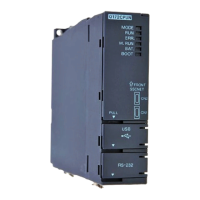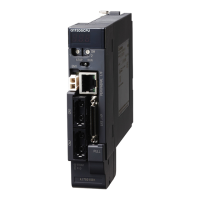5 - 10
5 OPERATION CONTROL PROGRAMS
(2) Bit device descriptions
Device description Device No. (n) specified ranges
Input relay Xn/PXn
0 to 1FFF
(Note-1)
Output relay Yn/PYn 0 to 1FFF
Internal relay Mn 0 to 12287
Multiple CPU area
device
U
\Gn
(Note-2)
10000 to (10000+p-1)
(Note-3)
Link relay Bn 0 to 1FFF
Annunciator Fn 0 to 2047
Special relay SMn
0 to 2255
(Note-4)
(Note-1): The range of "PXn+4 to PXn+F" cannot be used (fixed at 0) for the input device (PXn+0 to PXn+F)
allocated to the built-in interface in Motion CPU (DI).
(n: First input No.)
QDS
(Note-2):
= CPU No. (CPU No.1: 3E0, CPU No.2: 3E1, CPU No.3: 3E2, CPU No.4: 3E3). A CPU No. that
exceeds the number of CPUs in the Multiple CPU system cannot be set.
(Note-3): "p" indicates the user setting area points of the Multiple CPU high speed transmission area for each
CPU.
(Note-4): The range of "2000 to 2255" cannot be specified indirectly.
(a) When using the device in DIN or DOUT as batch bit data, specify "n" as a
multiple of 16.
(b) When using the device in Multiple CPU area device as batch bit data,
specify it as word device without making bit specification.
(3) Indirect specification of device No.
In the above word/bit device descriptions, device No. (n) can be specified
indirectly.
(a) Indirect specification of device No. (n) using word device
• The word device which the device No. was specified indirectly cannot be
used.
• You can use the 16-bit and 32-bit integer type word devices for indirect
specification.
The 64-bit floating-point type cannot be used.
• The word devices that can indirectly specify device No.(n) are shown
below.
• Data register (D)
• Link register (W)
• Motion register (#)
• Special register (SD)
(Description examples)
Good example Bad example
#(D10) #(D(D5))
D(#10L)F D(#4F)

